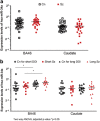Aberrant expression of microRNAs as biomarker for schizophrenia: from acute state to partial remission, and from peripheral blood to cortical tissue
- PMID: 26784971
- PMCID: PMC5068884
- DOI: 10.1038/tp.2015.213
Aberrant expression of microRNAs as biomarker for schizophrenia: from acute state to partial remission, and from peripheral blood to cortical tissue
Abstract
Based on our previous finding of a seven-miRNA (hsa-miR-34a, miR-449a, miR-564, miR-432, miR-548d, miR-572 and miR-652) signature as a potential biomarker for schizophrenia, this study aimed to examine if hospitalization could affect expressions of these miRNAs. We compared their expression levels between acute state and partial remission state in people with schizophrenia (n=48) using quantitative PCR method. Further, to examine whether the blood and brain show similar expression patterns, the expressions of two miRNAs (hsa-miR-34a and hsa-miR-548d) were examined in the postmortem brain tissue of people with schizophrenia (n=25) and controls (n=27). The expression level of the seven miRNAs did not alter after ~2 months of hospitalization with significant improvement in clinical symptoms, suggesting the miRNAs could be traits rather than state-dependent markers. The aberrant expression seen in the blood of hsa-miR-34a and hsa-miR-548d were not present in the brain samples, but this does not discount the possibility that the peripheral miRNAs could be clinically useful biomarkers for schizophrenia. Unexpectedly, we found an age-dependent increase in hsa-miR-34a expressions in human cortical (Brodmann area 46 (BA46)) but not subcortical region (caudate putamen). The correlation between hsa-miR-34a expression level in BA46 and age was much stronger in the controls than in the cases, and the corresponding correlation in the blood was only seen in the cases. The association between the miRNA dysregulations, the disease predisposition and aging warrants further investigation. Taken together, this study provides further insight on the candidate peripheral miRNAs as stable biomarkers for the diagnostics of schizophrenia.
Figures




References
-
- van Os J, Kenis G, Rutten BP. The environment and schizophrenia. Nature 2010; 468: 203–212. - PubMed
-
- Tsankova N, Renthal W, Kumar A, Nestler EJ. Epigenetic regulation in psychiatric disorders. Nat Rev Neurosci 2007; 8: 355–367. - PubMed
-
- Sullivan PF, Fan C, Perou CM. Evaluating the comparability of gene expression in blood and brain. Am J Med Genet B Neuropsychiatr Genet 2006; 141B: 261–268. - PubMed
Publication types
MeSH terms
Substances
LinkOut - more resources
Full Text Sources
Other Literature Sources
Medical
Molecular Biology Databases

